Inventory Forecasting with AI
10. Final model
Final Test – Full Dataset
Moment of truth: How does the model perform when run on all 15,000 items? Model and data configuration (based on previous findings):
- Feature engineering: 120 features (combination of individual sales and group-features)
- Outlier trimming
- Merging sparse categories
- Training only on items with at least 1 month of history
- Encoder length: 18 months
- Architecture: TFT
- Validation: last 3 months not included in training
For the final test, I selected a model with group features but without synthetic data. This setup proved to be the most stable across the entire assortment, although synthetic data remains an interesting option for future projects or specific subsets of products.
| Metrics | Full dataset | 33 months | 13-32 months | |||
|---|---|---|---|---|---|---|
| Value (ALL) | Value (Item) | Value (ALL) | Value (Item) | Value (ALL) | Value (Item) | |
| WAPE | 30.1022 | 49.7127 | 28.1069 | 41.6723 | 33.4304 | 40.1634 |
| RMSE | 45.907 | 22.3895 | 50.4051 | 23.9145 | 26.3204 | 17.0358 |
| R² | 0.9232 | 0.93 | 0.7245 | |||
| MAPE | 65.5438 | 57.332 | 60.9407 | |||
| ROBUST | 0.551 | 72.2735 | 0.5498 | 58.7128 | 0.5049 | 66.3819 |
| STABLE | 0.3884 | 0.3642 | 0.5422 | |||
| Metrics | 6-12 months | 1-6 months | no history | |||
|---|---|---|---|---|---|---|
| Value (ALL) | Value (Item) | Value (ALL) | Value (Item) | Value (ALL) | Value (Item) | |
| WAPE | 38.5444 | 45.8518 | 44.6778 | 47.1055 | 80.7317 | 220.7146 |
| RMSE | 26.6287 | 17.1458 | 43.1306 | 27.5178 | 95.9705 | 61.587 |
| R² | 0.7529 | 0.7451 | -0.1913 | |||
| MAPE | 64.676 | 79.1142 | 186.139 | |||
| ROBUST | 0.5233 | 66.5118 | 0.5441 | 89.7998 | 0.4013 | 250.967 |
| STABLE | 0.4801 | 0.4776 | 0.9196 | |||
Results by history length:
- Full history (36 months) – WAPE around 30% (ALL), high R² (0.92+).
- Medium history (12–35 months) – similar results to full history, with only a slight drop in R².
- Short history (6–12 months) – still solid forecasts, WAPE around 38%.
- Very short history (1–6 months) – higher errors, but still usable for rough planning.
- No history – predictions remain unusable; the model has no data point to determine the correct scale.
Compared to Chapter #9 (partial dataset test), the metrics are practically identical – the model maintains stability even with triple the dataset size. A slight improvement is visible for SKUs with short history, mainly thanks to a greater number of categories within groups → richer embedding data → better pattern transfer.
Visualization
The charts compare the prediction from the partial dataset (previous chapter) with the new prediction from the full dataset.
- 🔴 Red – prediction from the model on the partial dataset.
- 🟢 Green – prediction from the final model on the full dataset.
The most visible differences are found in SKUs with short history – here, group-level information now plays a much stronger role. For longer histories, the curves almost perfectly overlap, confirming that expanding the training dataset to the full range did not harm performance for established items.
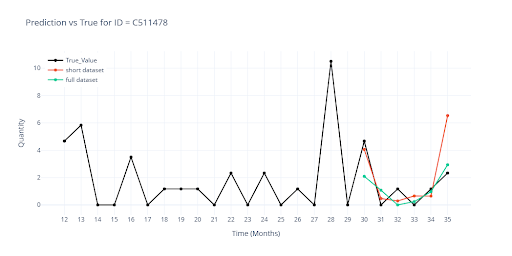

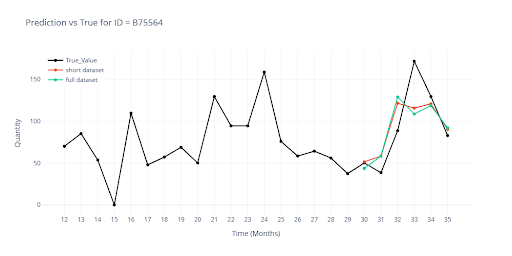

Promo Campaigns
The model performs very well on the full dataset, so I also tested how it handles promotional campaigns. In the training data, the model receives information about when and how long a given product was on sale. Within feature engineering, I also add additional context:
- how often the item has promotions
- how long promotions typically last
- what their historical impact on sales has been
The visualization shows the difference in forecasts when an item had a planned discount vs. no discount.
- 🔴 Red – without planned discounts
- 🟢 Green – discount applied in the last 3 months

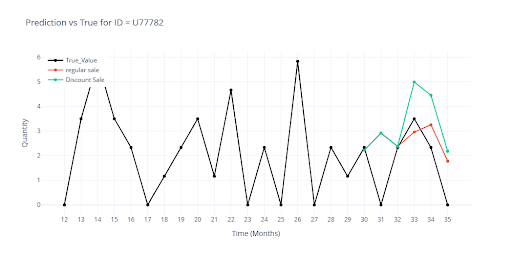
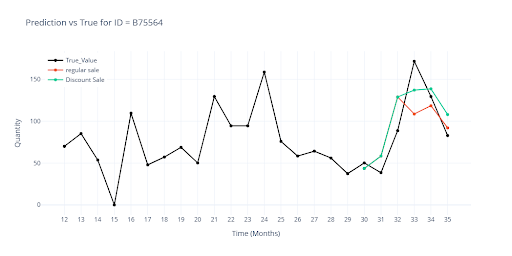
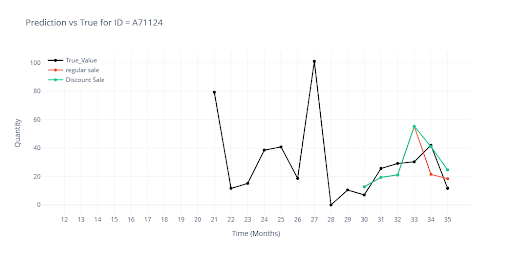
- Where history confirms the success of promotions, the sales forecast increases.
- Where past campaigns have not worked, the curve remains almost unchanged (e.g., C511478).
This shows that the model can make decisions based on the actual historical impact of promotional events, and that a discount by itself is not a universal trigger for increased sales.
Production Model
To deliver a complete solution to the customer, I trained the final version of the model – this time on the entire 42-month history (some months months have passed since the start of the project).
This time, there is no validation window, so the evaluation is done by visually comparing the model’s output with the customer’s internal forecast and the actual sales (which I backfilled retrospectively). Even without precise metrics, the key takeaway is that the customer is satisfied and sees clear value in the project.
What the visualization app shows
- ⚫ Historical data – actual sales
- 🔵 POC prediction – output from the test model with only basic settings
- 🟢 Final prediction – final model
- 🔴 Customer forecast – customer’s internal forecast
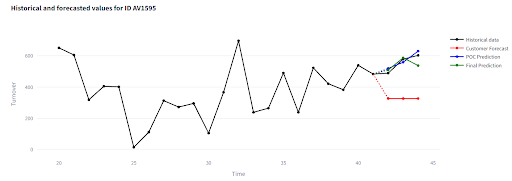

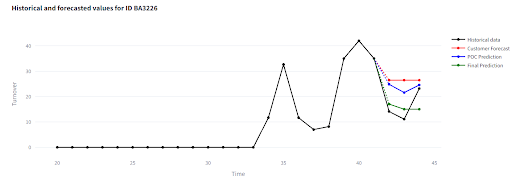
- In most cases, the model’s predictions stay very close to actual values
- Deviations appear mainly in anomalous sales that differ significantly from normal behavior
- The model reliably captures seasonal patterns and maintains their shape even when volumes fluctuate
- It can correct errors in the customer’s manual forecast
- For items with shorter history, predictions are more influenced by group behavior, which can lead to deviations from reality
- New items with less than 6 months of history remain challenging – accuracy starts to drop noticeably in this range
👉 Try the results yourself: https://demo-inventory-forecasts.streamlit.app/
(If the app is sleeping, click “Yes, get this app back up!” – it will be ready in under a minute.)
Note: All data shown is anonymized and slightly modified to remain informative.
Conclusion of the Series – Inventory Forecasting with AI
After ten chapters, thousands of experiments, and terabytes of trained data, I’ve finally reached the final solution.
Throughout the project, I have:
- Built a robust data processing and feature engineering pipeline
- Handled outliers effectively
- Included items with incomplete history
- Tested dozens of scenario, model, and configuration combinations
- Introduced group-features for transferring knowledge between similar items
Final choice:
A TFT model with group-features, without synthetic values, trained on items with at least 1 month of history.
The result?
Stable predictions across the ntire assortment, strong seasonality preservation, and the ability to correct errors in the customer’s manual forecasts.
